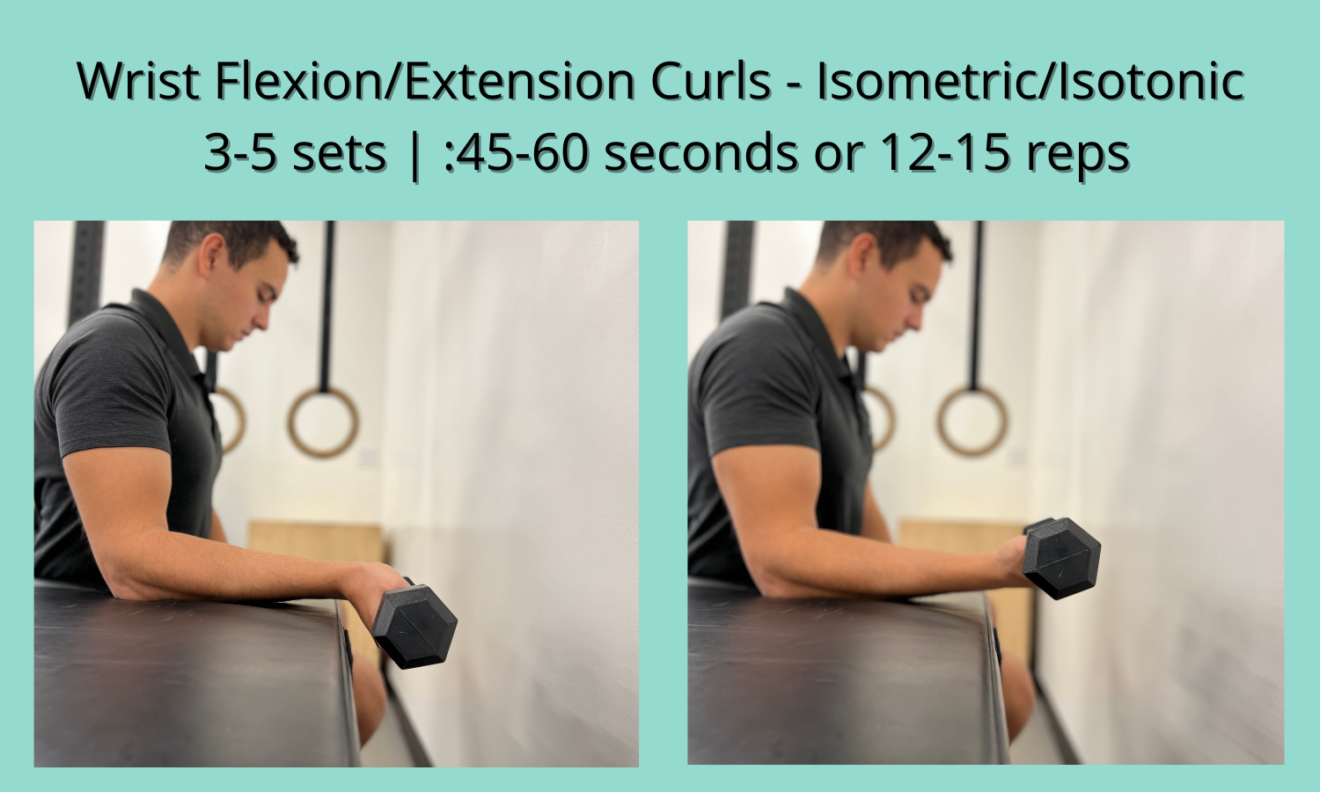Pickle/Tennis Elbow
Here at Cuirim Sports Recovery, we work with a ton of tennis and pickle ball players to get them out of pain so they’re able to perform their best on the courts. One of the most common injuries that people come to us for is lateral epicondylitis or most often known as tennis/pickle ball elbow.
We have a simple 3-step process to tackle this frustrating problem:
Reduce pain
Build endurance of muscle and connective tissue
Build muscles and proper movement patterns that are root cause of the issue
If you want to watch all of the exercises and see how they’re done, click the video below! Otherwise you can read about each exercise and find the program of all of the exercises at the bottom.
Our first objective is to release the tightness of your wrist extensor muscles. These are often overworked from the repetitive actions of pickle ball/tennis.
1. Wrist Extensor Release
Put a tennis ball on the outside of the forearm and pin it against a wall.
Push your hip against the arm to put more pressure on the ball.
Keep the hand of the arm you’re working on relaxed
Find a tight spot, and keeping the ball still, move your wrist in different directions
Do for a total of 2-3 minutes, moving to a different tight spot every minute.
Now that you’ve released and down-regulated the tight and overworked wrist extensors, you’re going to work the opposite side of the forearm by doing some wrist flexor strengthening.
If you’re experiencing pain greater than a “3” on a scale of 1-10, then you’re going to start off with some wrist exercises with “holds” also known as isometrics.
2. Wrist Flexion Curl – Isometric
support your forearm on a table or bench, with elbow bent. counter/table/bed/couch arm with the palm facing up.
Hold a light weight (or can of beans/soup/whatever you have in the pantry) and curl your hand up toward your face, stopping when the back of your hand is parallel with the ground.
This will be your holding position before you lower the hand back toward the ground.
Do 3-5 sets of a 45-60 second hold.
Once you can do this with less than “3/10” pain then move to “Isotonic” version below
3. Wrist Flexion Curl– Isotonic
If you can do this with less than a “3/10” pain then use a full range of motion going up and down continuously for reps. You can start at 12-15 reps, but you really should be looking to go until you would only have 1-2 reps left in the tank.
4. Wrist Extension Curl– Isometric & Isotonic
Same parameters as the Flexion Curls; however you do the exercise with your palm facing down toward the ground.
5. Wrist Pronation
Like the wrist flexor exercise, support your forearm on a table or bench, with elbow bent.
Start with the dumbbell facing up
Rotate it outward, ending with your palm facing up.
Rotate back in until the palm is facing down
Move slowly and with control throughout the motion.
6. Wall Push-Ups
Put your hands on the wall at shoulder height in line with your shoulder.
Lower your body to the wall WITH THE WEIGHT IN THE BASE OF YOUR PALMS
Once your nose gets to the wall, TRANSFER WEIGHT TO YOUR FINGERS
Push yourself back to your starting position. Possible Compensations:
As you push up through your fingers, make sure to still keep the bottom of the palms on the wall. Typically, the first few reps will be more difficult to do this, and you might find yourself shaking a bit on the way up
As you lower and as you push-up, don’t let your elbows flare out to the side
Root Cause fixes
Since those who experience golfer’s elbow, typically engage in activities requiring higher demands of thoracic and shoulder mobility such as tennis and pickleball, improving these motions can potentially help reduce unwanted stress at the elbow
7. Shoulder Sweep
Lay down on the ground with your legs straight.
Cross one knee over the body, and hold that knee on the ground with the opposite hand (left hand on right knee).
With the hand that’s not on the knee, make a snow angel motion as you go from your hip to above your head.
Try to get your hand as close to the ground as possible, WITHOUT lifting the knee off the ground.
This will work on pec and shoulder tissue as well as your ability to rotate through your spine
8. T’s
Start lying face down or standing up and bent over.
Place your arms out to your side with your thumbs up to the sky.
FIRST pinch the shoulder blades back, then raises your arms up so that your hands are about the same height as your torso.
Do’s and don’ts
Don’t shrug your shoulders up as you pinch
Think “keep your ears away from your shoulders”
9. Y’s
Start lying face down or standing up and bent over.
Start with your arms 45 degrees from your head (doing your best village people impression to make a “Y”)
Don’t shrug UP too much when you pinch shoulder blades. Shouldn’t feel primarily in upper traps
10. Band Pull Aparts – If you have a band
Hold the band with your palms up
Keep arms straight
FIRST pinch shoulder blades back (just like the T’s)
Pull the band out to your side – hold for 2 seconds.
Slowly bring hands back to center.
11. Shoulder Taps
Start in a push-up position.
Open feet to a wider base.
Slowly raise one hand to tap opposite shoulder.
Alternate and touch other shoulder.
Don’t go too quickly
Don’t let the hips rotate when raising hand to touch shoulder
Summary
In order to most appropriately manage Pickle Ball/Tennis Elbow your goal is to build up the capacity of your elbow and surrounding tissues, so they can ultimately tolerate more load. You do this by reducing or modifying aggravating activities as needed (especially early in rehab) and implementing exercises within a certain pain threshold. This combined with a lesson from an instructor can also shed light on whether technique or equipment is playing a role in this problem.









